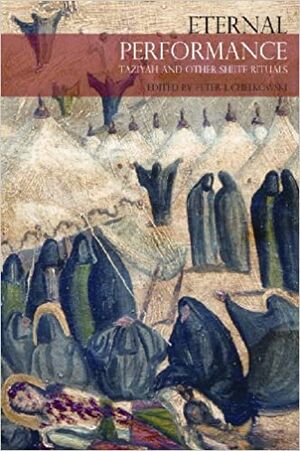Eternal Performance: Taziyeh and Other Shiite Rituals
 | |
| Author | Peter J. Chelkowski |
|---|---|
| Language | English |
| Genre | Historic |
| Published | 2010 |
| Publisher | Seagull Books |
| Pages | 425 |
The book Eternal Performance Taziyeh and Other Shiite Rituals has numerous photographs of various ta`ziyeh performances in Iran and gives information about the ritual drama call ta`ziyeh in this country.
About the author[edit | edit source]
Peter J. Chelkowski received his M.A. in Oriental philosophy from Jagiellonian University, his Ph.D. in Persian from Tehran University of Iran, and his Postgraduate in history and Islamic studies from London. He is professor of Middle Eastern and Islamic studies at New York University. He joined the faculty of NYU (New York University) as a cultural historian of the Middle East in 1968. His academic background is an intensely multi-cultural, multi-disciplined one. He studied Oriental Philology at the Jagiellonian University in Cracow and Theater Arts in the School of Drama in the same city. After he moved to London, he studied Islamic Middle Eastern History and Culture at the School of Oriental and African Studies (SOAS). Finally, he went to Tehran University to study Persian Literature. While in Iran, he also worked for a charitable organization called CARE Mission.
He is the author of Mirror of the Invisible World and Ta’ziyeh: Ritual and Drama in Iran, among other works. He has been the recipient of awards and fellowships from the American Association of University Presses; the Smithsonian Institute; the Hoover Institute on War, Revolution, and Peace Fellowship; and the Social Science Research Council.
About the book[edit | edit source]
This book published in Seagull Books; Illustrated edition (December 15, 2010), has 425 pages and best sellers rank of 3,874,389 in Books.
Eternal Performance explores the social, political, cultural, artistic, and religious significance of Muharram rituals. It is a collection of 24 articles on this subject.
abstract of book[edit | edit source]
According to Moojan Momen the articles in this book can be divided into five main categories.
- The first category
In this part, there are articles providing general background and historical information about the ta`ziyeh. There is an introduction to the 680 AD battle of Karbala which is retold, re-enacted, and commemorated in the Shi'a religious theatre in Iran (ta’ziyyah).
First article written by Peter Chelkowski is the story of Husayn and Karbala and introducing the ta`ziyeh. There is then a translation by Rebecca Ansary Pettys of a sample ta`ziyeh play, one on the martyrdom of Husayn. Then Kamran Aghaie’s in his article elaborates on the story of Hussein, Taziyeh, and other mourning ceremonies for Hussein. Jean and Jacqueline Calmard review the history of ta`ziyeh and then provide a translated of a report on the performance of taziyeh observed by Ilya Berezin, a Russian orientalist, in 1843 in Tehran. Terence O’Donnell gives description of a village ta`ziyeh performed in Iran. Iraj Anwar in his article mentions the development of the ta`ziyeh into secular and comical theatre occurring at any time of the year. This development took place in the early twentieth century, when support for the taziyeh ceased and they moved from the cities to rural areas where there was a demand for traditional taziyeh.
- The second category
The second category of articles deals with the theatrical aspects of the ta`ziyeh.
William Beeman and Mohammad Ghaffari describe the principles and skills needed to perform ta’ziyeh as well as the training that the actors receive. Mohammad Reza Khaki’s article analyses the space in which the ta`ziyeh takes place and are specially constructed for them (the Takiyeh). Sadegh Homayouni describes aspects of the literary forms and styles in Persian ta`ziyeh plays. Stephen Blum describes the music of the ta`ziyeh, where the heroes and the villains perform their parts.
- The third category
In this part, there are analytical and theoretical articles about the ta`ziyeh art form.
Negar Mottahede examines the gender consequences of taziyeh, in which male actors play female roles. Hamid Dabashi in his article about the 1979 Iranian Revolution looks at the paradox underlying the ta`ziyeh, the story of the Imam Husayn, his uprising against oppression and tyranny, his defeat and death. Janet Afary’s article is also about Iranian Revolution and looks at the theoretical analysis that Michel Foucault made of the Iranian Revolution.
- The fourth category
The articles of this category concern the export of ta`ziyeh from Iran to other Shi`i communities.
Fernea’s interesting article is about ta`ziyeh in an Iraqi village in 1957. The article by Peter Chelkowski deals with ta`ziyeh in India and ritual processions. It also describes the transfer of these rituals by Indian laborers in the 19th century to the Caribbean. Augustus Norton’s article deals with the rituals of mourning for Husayn in the Lebanon. Sabrina Mervin’s article describes how the ta`ziyeh has been adapted to Lebanese culture. Mary Hegland’s article has an interesting report of the Shi’i women of Peshawar, Pakistan, in 1991 and their rituals of the Karbala and the way that these rituals reinforce the male domination of society. Similarly, Bridget Blomfield’s article on Pakistani women in California looks at women’s mourning rituals and the manner in which these rituals create identity and agency in the participants.
- The fifth category
The fifth category, concerns attempt to stage ta`ziyeh performances in the West.
Milla Riggio describes the cultural, theatrical, and practical problems involved in the first attempt to stage a ta`ziyeh in the West, in 1988. Then Chelkowski brings an interview with Mohammad Ghaffari about productions of ta`ziyeh in his article. The article by Nigel Redden provides details about the New York City performance.